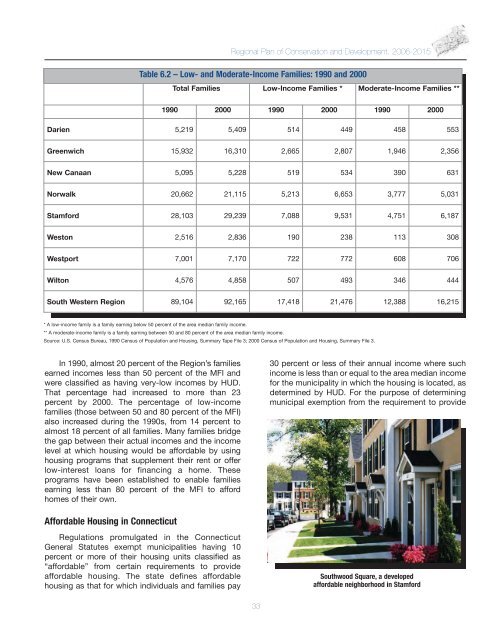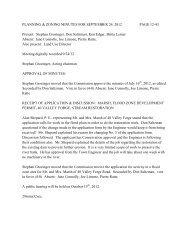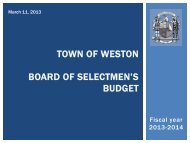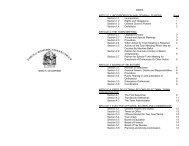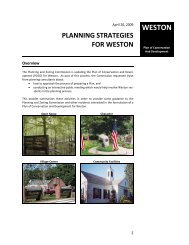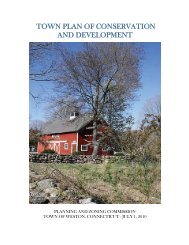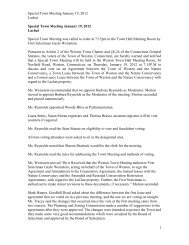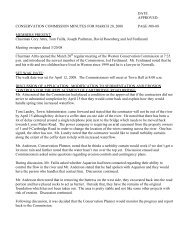<strong>Regional</strong> <strong>Plan</strong> <strong>of</strong> <strong>Conservation</strong> <strong>and</strong> <strong>Development</strong>, <strong>2006</strong>-<strong>2015</strong>Table 6.2 – Low- <strong>and</strong> Moderate-Income Families: 1990 <strong>and</strong> 2000Total Families Low-Income Families * Moderate-Income Families **1990 2000 1990 2000 1990 2000Darien 5,219 5,409 514 449 458 553Greenwich 15,932 16,310 2,665 2,807 1,946 2,356New Canaan 5,095 5,228 519 534 390 631Norwalk 20,662 21,115 5,213 6,653 3,777 5,031Stamford 28,103 29,239 7,088 9,531 4,751 6,187Weston 2,516 2,836 190 238 113 308Westport 7,001 7,170 722 772 608 706Wilton 4,576 4,858 507 493 346 444South Western Region 89,104 92,165 17,418 21,476 12,388 16,215* A low-income family is a family earning below 50 percent <strong>of</strong> the area median family income.** A moderate-income family is a family earning between 50 <strong>and</strong> 80 percent <strong>of</strong> the area median family income.Source: U.S. Census Bureau, 1990 Census <strong>of</strong> Population <strong>and</strong> Housing, Summary Tape File 3; 2000 Census <strong>of</strong> Population <strong>and</strong> Housing, Summary File 3.In 1990, almost 20 percent <strong>of</strong> the Region’s familiesearned incomes less than 50 percent <strong>of</strong> the MFI <strong>and</strong>were classified as having very-low incomes by HUD.That percentage had increased to more than 23percent by 2000. The percentage <strong>of</strong> low-incomefamilies (those between 50 <strong>and</strong> 80 percent <strong>of</strong> the MFI)also increased during the 1990s, from 14 percent toalmost 18 percent <strong>of</strong> all families. Many families bridgethe gap between their actual incomes <strong>and</strong> the incomelevel at which housing would be affordable by usinghousing programs that supplement their rent or <strong>of</strong>ferlow-interest loans for financing a home. Theseprograms have been established to enable familiesearning less than 80 percent <strong>of</strong> the MFI to affordhomes <strong>of</strong> their own.30 percent or less <strong>of</strong> their annual income where suchincome is less than or equal to the area median incomefor the municipality in which the housing is located, asdetermined by HUD. For the purpose <strong>of</strong> determiningmunicipal exemption from the requirement to provideAffordable Housing in ConnecticutRegulations promulgated in the ConnecticutGeneral Statutes exempt municipalities having 10percent or more <strong>of</strong> their housing units classified as“affordable” from certain requirements to provideaffordable housing. The state defines affordablehousing as that for which individuals <strong>and</strong> families paySouthwood Square, a developedaffordable neighborhood in Stamford33
South Western <strong>Regional</strong> <strong>Plan</strong>ning AgencyTable 6.3 – South Western Region Towns by State-defined AffordabilityTotal Housing Units(2000 Census)Total Assisted Units(calculated underSection 8-30g CGS)Percent AffordableDarien 6,792 123 1.81%Greenwich 24,511 1,114 4.54%New Canaan 7,141 176 2.46%Norwalk 33,753 3,972 11.77%Stamford 47,317 5,234 11.06%Weston 3,532 1 0.03%Westport 10,065 225 2.24%Wilton 6,113 159 2.60%Source: Connecticut Department <strong>of</strong> Community <strong>and</strong> Economic <strong>Development</strong>, 2004 Affordable Housing Appeals List. http://www.ct.gov/ecd/cwp/view.asp?a=1098&Q=249724&ecdNav=|affordable housing, the state includes housing that isassisted by a governmental program, such assubsidized units, homes with mortgages from theConnecticut Housing Finance Authority or the FarmersHome Administration, <strong>and</strong> deed-restricted units. Thishousing must be restricted to low or moderate-incomeindividuals or families as defined by the income eligibilityrules <strong>of</strong> the governmental program providing thefinancial assistance. “Moderate-income” families arethose earning between 80 <strong>and</strong> 120 percent <strong>of</strong> the MFI.It is important to recognize that HUD <strong>and</strong> the stateapproach the issue <strong>of</strong> housing affordability somewhatdifferently. HUD <strong>and</strong> the local housing authorities thatit supports use income to determine if a family orindividual qualifies for federal <strong>and</strong> state housingassistance based on income date from the mostrecent U.S. Census. The state determines whetherhousing units themselves are affordable using thecriteria established under the various governmentalprograms that support those units. However, the statedoes not count as “affordable” any housing units thatfall outside <strong>of</strong> the definition stated in the previousparagraph. This would include the Region’s smallsupply <strong>of</strong> relatively inexpensive market-rate housingsuch as mobile homes, certain condominiums <strong>and</strong>detached houses in generally undesirable locations orwhich are subst<strong>and</strong>ard to some degree. So, while thesupply <strong>of</strong> actual affordable housing is somewhatgreater than that which qualifies under the state’sdefinition, there still remains a significant shortage <strong>of</strong>affordable units in the Region.Those municipalities with less than 10 percent <strong>of</strong>their housing stock classified as affordable are subjectto appeals from developers whose applications aredenied by the local zoning commission, if affordablehousing that conforms to state requirements wasincluded as part <strong>of</strong> the application. Appeals are heardin specially designated courts throughout the state,<strong>and</strong> the burden <strong>of</strong> pro<strong>of</strong> is on the municipality, whichmust demonstrate health or safety reasons for thedenial <strong>of</strong> such an application.Other Housing ChallengesWhile there are programs in place for familiesearning less than 80 percent <strong>of</strong> the MFI, many familiesearning somewhat more may need housing assistanceas well. In fact, families living on $80,000 incomes<strong>of</strong>ten find themselves struggling to live in the Region.As a result, the needs <strong>of</strong> that segment <strong>of</strong> thepopulation earning between 80 <strong>and</strong> 120 percent <strong>of</strong> theMFI have become more prominent. These so-called“workforce” families represented 25 percent <strong>of</strong> allfamilies in the Region in 1990 but only 16 percent in2000. This trend was most evident in Norwalk <strong>and</strong>Stamford, the cities that have historically had the mostaffordable housing in the Region. The reasons for thisdecline include workforce families whose incomesrose above the 120 percent level, as well as those whomoved out <strong>of</strong> the Region (but who may continue towork in it), essentially trading a longer commute for alarger home.The housing needs <strong>of</strong> the Region’s elderly are alsobecoming more acute with the growth in this sector <strong>of</strong>the population. While many seniors are able to livecomfortably in their homes, others need assistance,34


